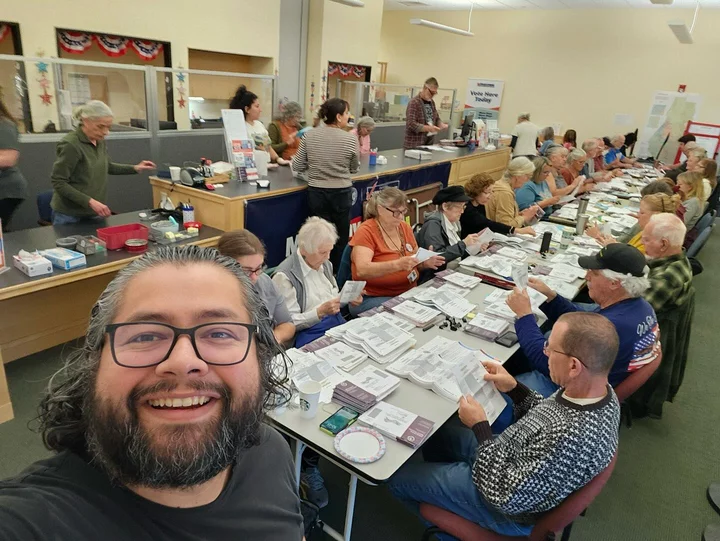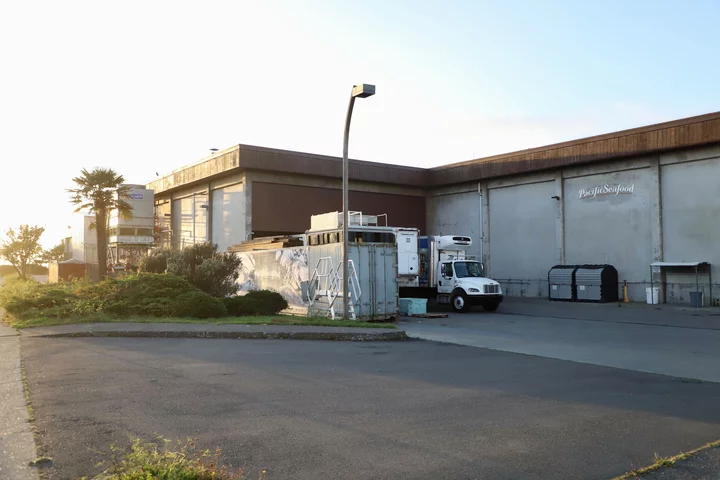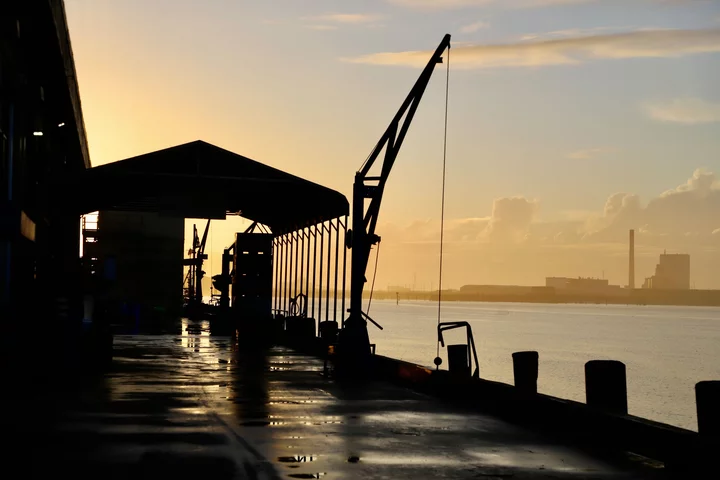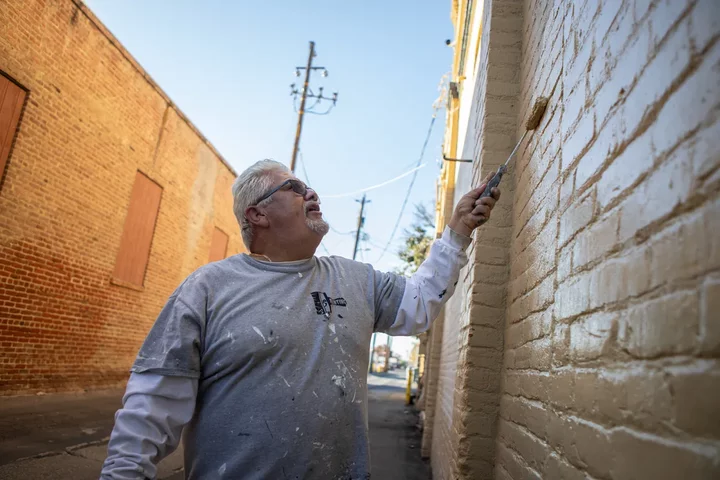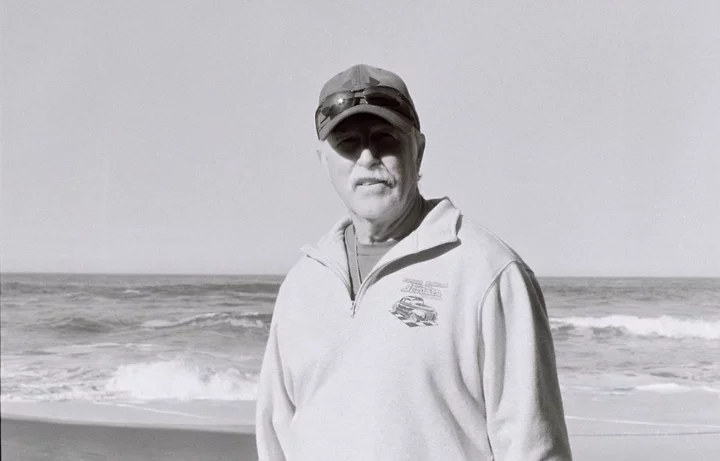With Only About 8,000 Humboldt County Votes Left to Tally, The Results are All the Same as They Were On Election Night — and are Now All But Certain (Except in Blue Lake)
Hank Sims / Friday, Nov. 15, 2024 @ 5:04 p.m. / Elections
Photo via the Election Office’s Facebook page.
###
PREVIOUSLY:
###
About 87 percent of the Humboldt County vote has been counted now, according to the Humboldt County Elections office, and what you thought you knew on Election Night is the same as what you know now.
Eureka City Council incumbents Scott Bauer and Kati Moulton win big, with — currently — about 68 percent and 62 percent of the vote, respectively. The “No on F” vote continues to hover just on the edge of 70 percent. The Arcata City Council incumbents are now almost certainly a lock, with Alex Stillman leading challenger Genevieve Serna — 2,893 votes to 2,410 votes.
Maybe the only close race? Up in Blue Lake, incumbent Adelene Jones currently trails challenger Kat Napier by only one vote. Ahead of them both are Michelle Lewis-Lusso and John Sawatzky. Three seats were open on the Blue Lake City Council, which means we’ll be waiting a while to find out whether the insurgent slate — which includes Lewis-Lusso, Sawatzky and Napier — made a clean sweep of it.
Press release from the Humboldt County Elections Office:
The Humboldt County Elections Office has released its second post-election results update following Election Day.
The Elections Office has approximately 8,021 unprocessed ballots as of today, Friday, Nov. 15.
- Provisional: 2,004
- Vote-By-Mail: 5,983
- Ballots from Voting Locations: 34
All valid vote-by-mail ballots will be counted regardless of the outcome or closeness of any race if they were postmarked by Tuesday, Nov. 5 and were received by Tuesday, Nov. 12.
The Humboldt County Office of Elections will continue to post the results of the November 5, 2024 General Election every Friday by 5 p.m. leading up to the certification of the election prior to Tuesday, Dec. 3.
For more information on the results of the election, please visit the Elections Results webpage or call 707-445-7481.
BOOKED
Today: 3 felonies, 4 misdemeanors, 0 infractions
JUDGED
Humboldt County Superior Court Calendar: Today
CHP REPORTS
Us101 S / Sr299 W Us101 S Con (HM office): Traffic Hazard
2755 Mm169 E Hum 27.60 (HM office): Hit and Run No Injuries
ELSEWHERE
RHBB: Helicopters Over Arcata Early Monday Were Searching for Missing Teen, Since Found Safe
KINS’s Talk Shop: Talkshop October 27th, 2025 – Rob Arkley
Governor’s Office: Governor Newsom highlights California innovation with Lockheed Martin Skunk Works’ X-59 named “Coolest Thing Made in California”
A State Appellate Court Says Weed is Illegal ‘Because Federal Law Says So.’ What Does That Mean for Humboldt?
Isabella Vanderheiden / Friday, Nov. 15, 2024 @ 4:42 p.m. / Cannabis , Courts
Photo by Jeff W on Unsplash.
###
A recent ruling by the Second District Court of Appeal is raising eyebrows among legal experts for its shocking assertion that cannabis is, in fact, illegal in California. Why? Simple: “Because federal law says so.”
“It is often said that cannabis is legal in California,” the Oct. 29 ruling states. “The statement is not true. Under federal law cannabis is illegal in every state and territory of the United States.”
The shocking determination emerged from a lawsuit – JCCrandall LLC v. County of Santa Barbara – that centers around road access to a permitted 2.5-acre cannabis farm, owned by Kim Hughes, near Lompoc in Santa Barbara County. JCCrandall LLC, a neighboring oat and barley farm, sued the county in 2021 over a Board of Supervisors decision that allowed Hughes to transport cannabis through the Crandall property via a pre-existing easement, according to an article published in the Santa Barbara Independent.
“The Hughes property lies adjacent to the Crandall property with a private access road connecting the two,” the article states. “The road — whose usage terms were laid out in an easement between property owners in 1998 — is the only means of accessing the Hughes property. … When the Board of Supervisors approved Santa Rita’s permit application in 2021, Crandall alleged that not only did this violate the terms of the easement, but it also violated federal law due to the illegality of cannabis at the federal level.”
A three-justice panel of the Second District Court of Appeal, Division Six, agreed with Crandall, adding that the county-issued conditional-use permit “is premised on JCCrandall being forced to allow its property to be used in cannabis transportation.” Not only that, but the scope of the easement “does not include the illegal transport of cannabis.”
“No matter how much California voters and the Legislature might try, cannabis cultivation and transportation are illegal in California as long as it remains illegal under federal law,” the ruling states.
Ettersburg resident Rod Silva came across the appellate court ruling two weeks ago while searching the internet for an attorney to help him sort out an easement dispute with a neighbor. Now, he’s hoping the court’s determination will prevent Humboldt County from approving new permit applications.
“I complained to the Planning Department and I just got the runaround,” Silva told the Outpost. “The final result was, ‘Well, that’s civil litigation between you and your neighbor.’ I’m just really tired of it because I feel like the county has given farms shortcuts, even when they’re out of compliance. … This case opens up a can of worms. I think the county will have to stop permitting farms and maybe eliminate all the [farms] they have already permitted.”
Silva is particularly concerned about a conditional-use permit application for The Hills, LLC, and Shadow Light Ranch, LLC, submitted by Garberville resident Joshua Sweet, who was fined $1.75 million in February for various environmental violations. The permit application appeared on the Humboldt County Planning Commission’s Nov. 7 agenda but it was continued to the commission’s next meeting on Nov. 21 due to time constraints.
Silva submitted a document – linked here – about the “landmark ruling” to the clerk of the Planning Commission, warning that commissioners “cannot approve any [conditional-use permits] for cannabis-related business because ‘cannabis cultivation and transportation are illegal in California as long as it remains illegal under federal law.’”
It remains to be seen what the recent judgment will mean for California’s weed farmers and other cannabis-related businesses.
Reached for additional comment on the matter, Humboldt County spokesperson Catarina Gallardo said, “The opinion in JCCrandall, LLC v. County of Santa Barbara is narrowly focused on the application of a specific provision within the Santa Barbara County Code.”
We also contacted the Department of Cannabis Control (DCC) for comment on the matter and were told that the DCC “does not comment on ongoing legal matters or the deliberations of local planning commissions.”
The County of Santa Barbara has until Dec. 9 to appeal the case to the California Supreme Court, though there is no guarantee that the court will hear the case.
Silva said he contacted one of the attorneys representing JCCrandall LLC to find out if the county was going to appeal. “He told me the odds are against [the county] because the California Supreme Court only hears roughly three percent of the cases submitted to them for appeal,” Silva said.
Reached for additional comment via email, Kelsey Gerckens Buttitta, a communications specialist for Santa Barbara County, told the Outpost that the county will seek review of the recent appellate court decision, but she did not say when the county would submit the appeal.
###
Pacific Seafood Halts All Processing in Eureka, Laying Off an Undisclosed Number of Employees
Ryan Burns / Friday, Nov. 15, 2024 @ 12:40 p.m. / Business , Fish
The Pacific Seafood plant at the intersection of Commercial Street and Waterfront Drive in Eureka. | Photos by Andrew Goff.
###
Pacific Seafood, the processing and distribution giant based in Clackamas, Ore., has halted all processing activity at its Eureka plant, dramatically scaling back its operations there and laying off an undisclosed number of local employees.
In an emailed statement, the company’s director of communications, Lacy Ogan, said the Eureka facility at 1 Commercial Street is still operating “but in the limited capacity of unloading oysters, crab, and groundfish as well as icing vessels” — i.e., providing flake ice for drag boats, salmon fishermen and other vessels that keep fresh catch onboard.
The seafood getting unloaded here in Eureka is now being shipped north for processing at Pacific Seafood plants in Oregon, Ogan said. The 83-year-old company has nearly 40 locations across the country — from Kodiak, Alaska, to Miami, Fla. — and employs somewhere in the neighborhood of 2,500 people nationwide.
Local fisherman Mike Cunningham, who has been selling his catch to Pacific Seafood for 35 years, said the company has removed much of its processing equipment and shipped it north to plants in Oregon, where it anticipates more abundant crabbing.
“They are going to continue to buy crabs here, and they have some residual processing capacity,” Cunningham said.
Last month, Pacific Seafood abruptly pulled out of Crescent City Harbor, leaving Del Norte County fishermen without the vital services of its ice plant. Owners of the company blamed “onerous” California Environmental Protection Agency regulations for its decision to move the ice plant to Charleston, Ore., the Del Norte Triplicate reported.
Ogan, the company spokesperson, told the Outpost that Pacific Seafood’s decision to halt processing here in Eureka was made due to “weak economic conditions coupled with a challenging regulatory environment.”
She did not respond to a follow-up email asking how many employees are being affected by this consolidation, though she wrote, “All impacted Team Members were given the opportunity to continue with Pacific at another location.”
Dave Bitts, another local fisherman, said Pacific Choice remains the largest single buyer of crab in the Port of Humboldt Bay.
“Regardless of what we think of the company, we definitely need that buying capacity,” Bitts said. “They’ve been it for a while.”
The loading dock at Pacific Seafood.
###
While this cutback in operations will negatively impact the local fishing industry, Pacific Seafood is not likely to leave altogether — not anytime soon, anyway.
Eureka City Manager Miles Slattery told the Outpost that the company signed a five-year lease renewal for city-owned warehouse earlier this year. Monthly lease payments for 1 Commercial street are a little over $13,000, he said.
“They’re still paying us rent and will continue to pay us rent,” Slattery said in a phone interview.
Typically referred to as Pacific Choice here in Northern California, the company was selected as Eureka’s business of the month in February of 2016. At the time it employed between 100 and 200 people in Eureka, depending on the season. Local fishermen estimate its recent employee count at somewhere near 60, maximum.
Cunningham said that Pacific Seafood ramped up the processing capacity at the Eureka plant a few years ago, production slowed dramatically last year.
“They really scaled back this summer,” Cunningham said. “They normally process drag fish here, but the market was really poor.”
Slattery heard the same thing. “I do know [Pacific Seafood] stopped purchasing bottom fish [and] other products a couple months ago, forcing our fishermen to go find other buyers,” he said.
The local drag fleet converted to fishing for shrimp, according to Cunningham, who compared the movement of equipment and boats to strategic chess moves. And he acknowledged that California has some unique market disadvantages.
“The manager told me what their PG&E bill [costs] a month to run that plant even in low production mode,” he said, adding that the number was “pretty staggering.”
One local employee posted to Facebook after receiving his layoff notice. He said his last day on the job will be his birthday, Dec. 2.
Photo by Andrew Goff.
Human Rights Commission Reaffirms Humboldt County’s ‘Sanctuary County’ Status, Will Discuss What That Means at its Next Meeting
LoCO Staff / Friday, Nov. 15, 2024 @ 11:22 a.m. / Local Government
Press release from the Humboldt County Human Rights Commission:
The Humboldt County Human Rights Commission (HCHRC) feels the time is right to issue a reminder that Humboldt County is a Sanctuary County. As a county Commission charged with advising the Board of Supervisors and others of the need to protect the rights of all residents of our county, the HCHRC takes this role seriously.
With the recent election results we are reminded of promises made to engage in mass deportations and other actions against immigrants. Our goal is to assure that residents with legal rights are protected from unlawful and inhuman actions. The HCHRC is charged to identify discrimination throughout our county, and to recommend to the Board of Supervisors possible ways to address such problems.
As chair, I will place this issue on the agenda of our next meeting, December 5, 2024 (hybrid, including zoom access) .at 5:30pm. Members of the public are invited to attend and comment on any agenda item. It is an obligation of all members of our society to demand that ignorant and unlawful actions be rejected for the good of all members of our community. The Commission also operates a phone message line for any questions, comments, or suggestions—(707-268-2548). A commissioner will return your call only if you leave your phone number.
Respectfully submitted,
Jim Glover, Chair
Humboldt County Human Rights Commission
‘A Pivotal Moment?’ Why Many Latino Voters in California Chose Trump
Yue Stella Yu / Friday, Nov. 15, 2024 @ 7 a.m. / Sacramento
Adrian Jurado, a painter, paints a wall for a business in downtown Los Banos on Nov. 7, 2024. Photo by Larry Valenzuela, CalMatters/CatchLight Local
MERCED – At first, Marlyn Huesgew Mendoza registered as a Democrat. In 2020, she re-registered as a Republican and voted for Donald Trump for president, as she did this election.
The reason is simple: It was in 2018 — when he was in office — that her family was finally able to buy a house in Merced. The same year, the Trump administration approved her Guatemalan mother’s citizenship application — one that had been rejected under President Barack Obama, she said. The approval letter had Trump’s signature on it.
“She’s like: ‘Look who adopted me,’” said Huesgew Mendoza, a 25-year-old graduate from University of California Merced and an administrative assistant at the Merced County Hispanic Chamber of Commerce.
“Once he came in and it was just so easy for us, I was like, ‘Huh, he might not be as scary as people may think.’”
Most — if not all — of California’s 12 Latino-majority counties gave a larger share of their vote to Trump compared to 2020, and counties with a higher share of Latino population swung further toward Trump, according to a CalMatters analysis of state voting data. Trump also expanded his vote share in most other counties in California.
But does that signal a rightward shift among Latinos and a departure from the Democratic Party in California?
The answer is complicated.

Absent conclusive demographic data on votes cast in this election, pollsters disagree over how much their surveys show Latinos shifting toward Trump. The AP VoteCast, which surveyed more than 120,000 voters nationwide in English and Spanish, shows 55% of Latino respondents supported Vice President Kamala Harris, while 43% backed Trump. In 2020, Joe Biden won 63% of the vote among Latino respondents versus Trump’s 35%.
But almost all polls reached the same conclusion: Latino support has grown for Trump.
A mix of factors contributed to the apparent shift: Inflation blamed on an unpopular administration, concern over border security, resistance to Democrats’ messaging on cultural issues and Harris’ lack of appeal, according to pollsters, experts, political consultants and a dozen Latinos in the Central Valley who spoke to CalMatters.

Marlyn Huesgew Mendoza, an administrative assistant at the Merced County Hispanic Chamber of Commerce, sits at a bench in front of her downtown Merced office on Nov. 7, 2024. Photo by Larry Valenzuela, CalMatters/CatchLight Local
How much other Republicans gained from the growing support for Trump remains to be seen. Nationwide, Democrats won four of the five battleground U.S. Senate seats and declared victory on abortion rights ballot measures in Arizona, Missouri and Nevada.
In California, with 88% of the estimated vote counted, Trump has received slightly fewer votes than Republican U.S. Senate candidate Steve Garvey. And in some counties within the state’s toss-up congressional districts, Democratic candidates appear to be outperforming Harris. In Merced County, which falls entirely into the 13th Congressional District, Democrat Adam Gray has received 5 percentage points more of the vote than Harris, with nearly 80% of the votes counted.
For Gray, who is narrowly trailing Republican Rep. John Duarte, this election does not reflect voters flocking toward Republicans.
“What you want to call a rightward shift, I would call a rejection of more of the same. Voters are saying … ‘We want you guys to change,’” he told CalMatters. “I think people want to see us get back to the basics, and if I’m elected to Congress, I’m going to do just that.”
But Mike Madrid, a longtime GOP consultant with an expertise in Latino politics, called this election a “five-alarm fire” for Democrats, who he said have gradually lost support among Latino voters since 2012. He pointed to a pair of Pew Research Center surveys, which suggested Latino support for the Democratic presidential candidate dropped from 71% for Obama in 2012 to 59% for Biden in 2020.
In California, a majority of Latinos have firmly supported Democrats after former GOP Gov. Pete Wilson championed Proposition 187, which was approved by voters in 1994 to deny benefits to undocumented immigrants but was blocked by the courts. But that support could erode as cost of living increases, alienating working-class residents, many of whom are Latinos, Madrid said.
“I think this is a pivotal moment. I think it’s as significant as the Prop. 187 moment in 1994, except it was a wake-up call for Republicans,” Madrid said.
But some experts warned it may be too early to tell if the past three presidential elections are a referendum on the Democratic Party, given that Democrats have won toss-up statewide races in battleground states and have won every statewide race in California since 2006.
This election is an outlier, with Biden withdrawing from the race and passing the torch to Harris so late in the campaign, said Roberto Suro, a professor of journalism and public policy at the University of Southern California.
“You’ve got to put an asterisk on this election, or actually, multiple asterisks. Trump as a candidate is a giant asterisk,” Suro said. “Trying to say we are seeing any kind of permanent realignment is a mistake.”
‘The bottom line is money’
Huesgew Mendoza isn’t alone in believing that her life changed for the better after Trump took office in 2017.
Sandra Izaguirre, a 34-year-old in-home caretaker from Lancaster in Los Angeles County, said she supported Obama in 2008, but not in 2012. Then a first-time mother working at a fast food restaurant, Izaguirre needed health care. Obamacare required bigger businesses to provide full-time employees health benefits or pay a fee, so Izaguirre said her employer just cut her hours to disqualify her.
“I wasn’t improving. If anything, I was hurting more,” she said. “I just wanted a change already.”
That drove her to vote for Trump in 2016. A year later, Izaguirre said, she was able to buy her first home.
But because she couldn’t work as an in-home caregiver during the COVID-19 pandemic, she said she almost defaulted on her house but was saved by a federal mortgage relief program approved on Trump’s watch. The economic downturn, mixed with the state’s failure to stop unemployment benefits fraud, was “a recipe for disaster,” she said.
Even economic concerns, however, weren’t enough to drive Izaguirre to the polls this November. But that’s not because she didn’t support Trump: She said her vote for him in deep-blue California would not have made a difference anyway.

Political signs along Highway 152 leading into Los Banos on Nov. 9, 2024. Photo by Larry Valenzuela, CalMatters/CatchLight Local


First: A family walks through downtown Delano on Nov. 8, 2024. Last: A mural painted on a power box in downtown Merced on Nov. 7, 2024. Photos by Larry Valenzuela, CalMatters/CatchLight Local
But the economy is top of mind among Latino voters, as well as among voters overall, as polls have consistently shown throughout the 2024 campaign. Latino and Black Americans are the most likely to feel the pinch of high inflation compared to the overall population, according to a 2022 analysis by the Federal Reserve Bank of New York.
Latinos in California make up 40% of the state’s population but more than half of poor Californians, according to an analysis by the Public Policy Institute of California last year. The poverty rate among Latinos rose to 16.9% in fall 2023 compared to 13.5% in fall 2021, the analysis shows.
It’s a pain felt by Annissa Fragoso, a Merced insurance agent who voted for Harris this year. As a business owner, she said, she’s “struggling a lot with the insurance industry” and growing frustrated with state Insurance Commissioner Ricardo Lara, a Democrat.
“The Latinos in the past were registered and supportive of the Democratic Party, but it has not been very supportive of us,” she said.
Fragoso, who lost in the March primary for the Merced County Board of Supervisors, said she spoke to a lot of Latino voters who saw Trump as an agent of change on the economy.
“The bottom line is money,” she said.

Annissa Fragoso, an insurance agent, works at her desk in downtown Merced on Nov. 7, 2024. Photo by Larry Valenzuela, CalMatters/CatchLight Local
Adrian Jurado, a painter in Los Banos who said he never registered to vote since he believed he couldn’t make a difference, said that ever since the pandemic, there were fewer painting jobs because people weren’t willing to spend anymore. But when Trump was in office, he said, the economy seemed better.
“I’ve never had it like this,” he said. “It used to be that you could put a little bit away. I wasn’t able to put nothing away.”
While consumer prices have climbed by 20% over the past four years, average wage gains actually outpaced inflation, according to an analysis by the NBC News. But that does not match people’s perception, as expenses keep rising, the analysis says. Many voters frustrated with the economy embraced Trump, even as economists warn that Trump’s proposed tariffs could hike prices even further nationwide as well as in California.
But voters may be punishing incumbents rather than voting for Republicans, said Rodrigo Dominguez-Villegas, research director at the Latino Policy & Politics Institute of UCLA.
“You get reminded of those high prices every single day because you are buying something every single day,” he said. “High inflation was a global phenomenon. It was not unique to the United States. But who happened to be in power when it happened? It was Biden and Harris.”

People walk through downtown Delano on Nov. 8, 2024. Photo by Larry Valenzuela, CalMatters/CatchLight Local
Julián Castro, CEO of the Latino Community Foundation, said Trump’s win resembles the victories of Ronald Reagan in 1980 and George W. Bush in 2000: All three campaigned against a Democratic administration that “faced headwinds,” he said.
“In 1980, the economy was similar to 2024, at least in people’s minds,” Castro said. “In 2000, after eight years of Democratic governance, there was a pent-up demand for a change.”
But even though they are frustrated at the economy under the Biden administration, most Latinos who spoke to CalMatters said it doesn’t mean they will continue to vote Republican.
“I’ll just see how it goes in the (next) four years,” Izaguirre said.
‘That’s not me’
Trump has promised to conduct the largest deportation in American history, targeting immigrants in the country illegally, with or without criminal records.
But Izaguirre, as well as other Latino Trump supporters who spoke to CalMatters, said they do not want undocumented immigrants who have been working in the country for years to be deported. The majority of them supported providing legal status for those immigrants — a policy Democrats have championed.
Trump’s victory has terrified some migrants at the border and undocumented immigrants in California.
“I feel worried because I don’t know what the future will be for us people who don’t have documents, and we work here,” an undocumented immigrant in Delano told CalMatters in Spanish. CalMatters is not naming him due to his concern for his safety.
But others said Trump’s mass deportation plan would not touch them.
“He said he was going to deport people who have a bad record. That’s not me. I don’t have a bad record,” said a farmworker in Stanislaus County who spoke to CalMatters on the condition of anonymity and who said she came to the country by paying off a “coyote” — a term for smugglers — 20 years ago.
Huesgew Mendoza likened Trump’s mass deportation to yelling fire in the theater. “It just sounds too scary, too major,” she said.
And Aaron Barajas, 46, who voted for Trump this year in his first presidential election, slammed policies that would “rip people apart from their family,” arguing those who are already established in the United States should be allowed to obtain legal documents. But he distinguished between those who are already living here and those who wish to come in, arguing Trump merely wants to “bring people into our country, but do it the right way.”


First: Aaron Barajas, an insurance agent, sits at a bench in front of his downtown Merced office on Nov. 7, 2024. Last: Political signs along Highway 152 leading into Los Banos on Nov. 9, 2024. Photos by Larry Valenzuela, CalMatters/CatchLight Local
It appears Trump’s rhetoric on immigration has not deterred Latinos from voting for him, unlike the assumption Democrats have made following the passage of Prop. 187, Suro said.
“The hypothesis was that, when confronted with threats to the immigrant population and xenophobic rhetoric and harsh exclusionary measures toward immigrants … you would alienate Latinos,” he said. “Trump has very vividly disproven that.”
That’s in part because of “scapegoating” by Trump and his allies, who targeted migrants “physically at the border” for mass deportation, Castro said. “They cleaved the recent arrivals from people who have been here for a long time, and that’s why I think you hear people express confidence that he doesn’t mean them.”
Another factor could be the rapidly changing demographics among Latinos in California, as more young, U.S.-born Latinos become eligible to vote, experts say.
“Overall, fewer Latinos are as close as they used to be to the immigrant experience,” said Mindy Romero, founder and director of the Center for Inclusive Democracy. “How close you are to the immigrant experience can directly affect how you view policy on internal (immigration efforts) versus border (immigration).”
The anti-immigrant sentiment could even be appealing to some Latino voters who are “fueled by a deep desire to assimilate or to be seen as belonging to a larger American culture and to differentiate themselves from those who are seen as outsiders,” said Dominguez-Villegas at UCLA.
A referendum on Democrats?
While it’s too early to draw firm conclusions from the election, the takeaway for Democrats is that they must be better at reaching Latino voters, something both major parties have done poorly in California, political consultants say.
California Democrats are “clearly in danger of losing Latino support long term” due to “bad branding” that lasted for more than a decade, Madrid said.
But, he added, “there’s very little evidence that suggests Latinos are becoming more conservative. There’s a lot suggesting they are becoming more populist.”
Michael Gomez Daly, a senior strategist with the progressive California Donor Table, said he’s unsure how best to counter the backlash Democrats faced from voters hurt by inflation, stressing that voters may remember Trump with “rose-colored glasses.”
However, he said, Trump proved “inspiring” among Latino voters even with his “problematic” rhetoric. Living in the toss-up 41st Congressional District where GOP Rep. Ken Calvert narrowly defeated Democrat Will Rollins, Gomez Daly said he saw conservative YouTube ads targeting young men all the time.
“I think Democrats need to recognize the economic situation that much of inland California is facing and speak to those problems and give hope to people,” he said. “I think that was lacking.”
###
CalMatters’ data reporter Jeremia Kimelman contributed to this story.
CalMatters.org is a nonprofit, nonpartisan media venture explaining California policies and politics.
OBITUARY: Harold William Shamp, 1951-2024
LoCO Staff / Friday, Nov. 15, 2024 @ 6:56 a.m. / Obits
Harold
William Shamp peacefully passed away Nov. 11, 2024 in Arcata at the
age of 73. He was a native of McKinleyville but had called Arcata his
home for the past 55 years. Harold graduated from McKinleyville High
School in 1969. He worked at Simpson after high school and would
later graduate from College of the Redwoods. He then worked as a supervisor at Humboldt Bay Municipal Water District for 23 years
until he retired in 2006.
Harold was a very active supporter of youth sports. He coached basketball at St. Mary’s Elementary School in Arcata and coached Joe Costa Trucking for the Arcata Little League for several years. As his children grew older, he joined the St. Bernard High School Crusader Athletic Board and proudly wore the CAB green jacket, where he did everything from working concessions, helping with Sunday bingos, and working the ticket booth. He was a regular fixture in the corner of the SBHS gym which there is a plague declaring that corner as “Shamp Corner.” He was a strong supporter of his family and a huge sports fan.
He is survived by his children, Brady (Michelle) Shamp of Eureka, Lindsay (Lee) Manghelli of Harrisburg, Ore., and Casey Shamp of Arcata; his grandchildren, Ashlyn Manghelli and William Manghelli, of Harrisburg, Ore.; his brother and sister, Don Shamp of Connecticut, and Patty Wade of McKinleyville; and numerous nieces and nephews. He is also survived by his loving companion, Rosemary Fitzpatrick.
He was preceded in death by his wife, Linda; his parents Delbert and Violet Shamp; his brothers Delbert Shamp and Ron Shamp; his sister, Joyce Redden, and his in laws Joseph and Mary Gomes.
Visitation for Harold will be held on Saturday, November 16, 2024 from 2 to 4 p.m. at Paul’s Chapel in Arcata. A celebration of life will be held at a later date.
Arrangements are under the direction of Paul’s Chapel in Arcata.
###
The obituary above was submitted on behalf of Harold Shamp’s loved ones. The Lost Coast Outpost runs obituaries of Humboldt County residents at no charge. See guidelines here. Email news@lostcoastoutpost.com.
OBITUARY: Allen LeRoy Mann, 1954-2024
LoCO Staff / Friday, Nov. 15, 2024 @ 6:56 a.m. / Obits
Allen LeRoy Mann
May 30, 1954 – November 7, 2024
Allen Mann, a devoted husband, father, and grandfather, passed away peacefully on November 7, 2024, in Eureka, at the age of 70. Born in Marysville, Calif. Allen’s life was filled with dedication to his family, commitment to his community, and passions that brought joy to those around him.
Allen loved the outdoors, often spending time hunting and fishing. He was also a passionate car enthusiast, regularly entering his cars in shows, where he proudly earned 43 awards over the years (but who’s counting). His love of cars led him to volunteer with the Boys and Girls Club’s annual car show, “Cruz’n Eureka,” where he became actively involved with the organization. Known for his amazing sense of humor and storytelling, he had a gift for making those around him laugh through his previous experiences.
He began his career in law enforcement as a campus police officer at Yuba College and went on to serve as a sheriff’s deputy in Yuba County. Allen later retired as a detective with the Redwood City Police Department and began a second career in corporate security at FedEx, continuing to serve with integrity and dedication.
He is survived by his beloved wife, Karen, and his four daughters, Laura-Lisa, Chelsea, Mary-Caitlin, and Shyleigh, as well as his grandson, Hunter. All his children and his 33 foster kids brought him endless joy… and humor. As he would say, sarcastically, “I need more kids”. Allen and his family made their home in Blue Lake, where he was a treasured part of the community and will be deeply missed.
A funeral mass will be held at 10 a.m. on Friday, November 22, at St. Mary’s Church in Arcata. A memorial gathering will follow at 1:30 p.m. at the Portuguese Hall in Arcata, where family and friends are invited to celebrate Allen’s life, love and legacy.
In lieu of flowers, if you wish, you may bring an unwrapped toy to the memorial, which will be donated to Toys for Tots. Allen volunteered regularly with Toys for Tots over the last several years, a cause close to his heart.
Allen’s warmth, humor, and dedication to his community touched countless lives. He will be remembered as a man who lived fully, gave generously, and left a legacy of laughter, love and kindness.
###
The obituary above was submitted on behalf of Allen Mann’s loved ones. The Lost Coast Outpost runs obituaries of Humboldt County residents at no charge. See guidelines here. Email news@lostcoastoutpost.com.

